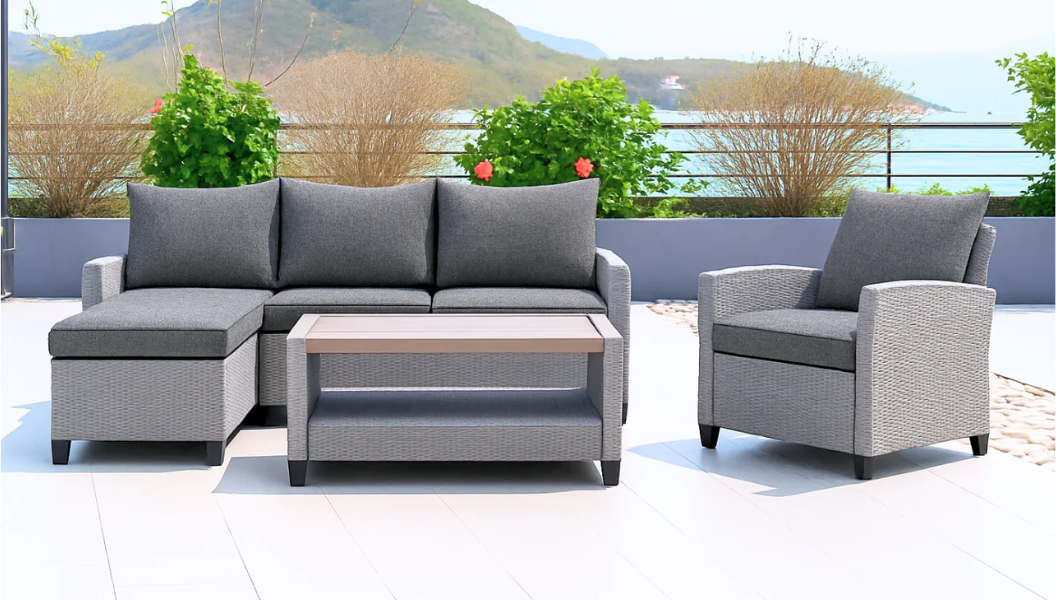
Rattan Garden Sofas: Real vs. Synthetic — The Insider’s Guide
Share
If you’ve ever shopped for rattan garden sofas, you’ve probably noticed the same thing: they all look great in the photos, but the prices vary wildly. Some sets cost a few hundred pounds, others run into the thousands. What’s going on?
Here’s the truth the furniture industry doesn’t usually share: most “rattan garden sofas” aren’t actually made of rattan at all.
So what does this really mean for you the consumer? And how to tell if a garden sofa set is worth your money? We're here to explain...
What exactly is rattan?
Natural rattan: A climbing palm native to Asia, stripped into canes and woven by hand. Think of it as the cousin of bamboo, but more flexible.
Synthetic rattan: Usually made of polyethylene (PE) plastic strands designed to look like natural rattan, often woven around an aluminium frame.
Here’s the kicker: 99% of rattan garden sofas you see online or in garden centres are synthetic. Why? Because real rattan doesn’t survive outdoors.
Comparison Table: Natural vs. Synthetic Rattan
| Feature | Natural Rattan | Synthetic Rattan (PE) |
|---|---|---|
| Durability Outdoors | Poor – rots, cracks, mould | Excellent – weatherproof |
| Maintenance | High – needs protection from damp | Low – wipe clean, minimal upkeep |
| Look & Feel | Warm, natural, handcrafted | Modern, consistent, stylish |
| Price | Expensive, artisan furniture | Wide range – cheap to luxury |
| Best Use | Indoor conservatories, sheltered areas | Outdoor garden furniture, garden sofa sets |
The Myth of the “Natural” Rattan Garden Sofa
Furniture retailers love to use words like “authentic”, “handwoven”, and “traditional rattan look”.
But if you see a sofa marketed as “rattan” for outdoor use, it’s almost always synthetic.
Natural rattan:
Looks beautiful indoors
Cracks and rots if left in the rain
Attracts mould in damp climates
So, unless you plan to keep your garden furniture inside a conservatory, synthetic rattan is the only real option for outdoor

Synthetic Rattan: Not All Created Equal
Here’s where the price difference really comes in.
The good stuff (premium PE rattan):
UV-resistant, so it doesn’t fade in the sun
Strong, flexible, and woven tightly
Usually hand-woven around rust-free aluminium frames
The cheap stuff (PVC rattan):
Brittle, especially in cold weather
Splits and frays after a season or two
Usually wrapped around steel frames that rust when the coating chips

To put it simply: Two sofas can look identical online — but one is built to last 10 years, the other might show heavy signs of wear after only a couple of summers.
What to Look For in a Garden Sofa: The Insider's Checklist
Want to make an informed purchasing decision? Of course you do. Whether you're browsing garden sofa sets online or heading in-store, remember to keep these factors in mind:
Frame material: Aluminium > steel (rust-proof vs rust-prone)
Weave type: Flat weave is cheaper; round or half-round looks better and usually lasts longer
Cushion quality: Dense foam and removable covers mean they won’t flatten immediately
UV rating: If it doesn’t mention UV resistance, expect fading
Guarantee: A solid brand will back their rattan garden sofas with at least 2–5 years warranty

Should You Choose Rattan or Something Else?
Rattan (synthetic) is popular because it’s stylish, lightweight, and weather-resistant.
But it’s not the only option:
Wooden garden sofas: Classic, sturdy, but need more maintenance
Metal lounge sets: Sleek and durable, but can heat up in the sun
Rope and fabric sets: Trendy, but often less durable outdoors
I’ll be covering each of these in future posts — and revealing where the marketing hype doesn’t match reality.

The Bottom Line
When you see “rattan garden sofas”, remember this:
They’re not natural rattan (and that’s a good thing)
The price gap comes from materials you don’t see — the frame, the weave, and the cushions
Ask the right questions and you’ll avoid the overpriced, underperforming sets that retailers push hard in summer
The next time you shop for a garden sofa set, you’ll know exactly what’s real, what’s synthetic, and what’s worth your money.
Rattan Sofa FAQs
Can rattan garden sofas be left outside all year?
Yes, synthetic rattan garden sofas can stay outdoors year-round. Just invest in a cover to protect the cushions and extend the life of the frame.
How long do rattan garden sofas last?
Premium PE rattan sofas with aluminium frames can last 7–10 years. Cheaper PVC versions may only survive 2–3 summers.
Are rattan garden sofas waterproof?
The rattan itself is weather-resistant, but the cushions are not. Always store or cover cushions to prevent mould and waterlogging.
Do synthetic rattan sofas fade in the sun?
Quality rattan is UV-stabilised and won’t fade. Cheaper versions without UV protection will bleach and crack in direct sunlight.
What’s better — rattan or wooden garden sofas?
Rattan (synthetic) is lower maintenance and more weatherproof, while wood offers a natural look but needs regular care.
